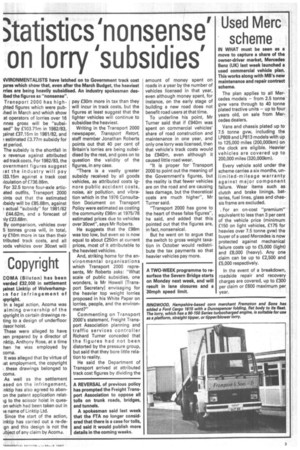3tatistics'nonsense' on lorry 'subsidies'
Page 3

If you've noticed an error in this article please click here to report it so we can fix it.
WIRONMENTALISTS have latched on to Government track cost lures which show that, even after the March Budget, the heaviest rries are being heavily subsidised. An industry spokesman desibed the figures as "nonsense".
Transport 2000 has highjhted figures which were pubihed in March and which show at operators of lorries over 16 ,nnes gross will be "subsised" by £103.71m in 1982/83, jainst £37.15m in 1981/82, and estimated £3.77m subsidy for at period.
The subsidy is the shortfall in x revenue against attributed lad track costs. For 1982/83, the overnment figures suggest at the industry will pay i'33.15m against a track cost ilculation of £736.86m.
For 32.5 tonne four-axle articated outfits, Transport 2000 )ints out that the estimated ibsidy will be £135.88m, against ) actual "subsidy" for 1981/82 £44.62m, and a forecast of ily £23.68m.
By comparison, vehicles over 5 tonnes gross will, in total, iy £10m more in tax than their tributed track costs, and all )ods vehicles over 30cwt will pay £30m more in tax than they will incur in track costs, but the figures at least suggest that the lighter vehicles will continue to subsidise the heaviest.
Writing in the Transport 2000 newspaper, Transport Retort, staff member Jonathan Roberts points out that 40 per cent of Britain's lorries are being subsidised by the rest, and goes on to question the validity of the figures, in any case.
"There is a vastly greater subsidy received by all goods vehicles, as attributed costs ignore public accident costs, noise, air pollution, and vibration which in the 1976 Consultation Document on Transport Policy were estimated as costing the community £98m at 1975/76 estimated prices due to vehicles over 30cwt", says Mr Roberts.
He suggests that the £98m was too low, but even so is now equal to about £250m at current prices, most of it attributable to the heaviest vehicles.
And, striking home for the environmental organisations which Transport 2000 represents, Mr Roberts asks: "What scale of public subsidies, one wonders, is Mr Howell [Transport Secretary) envisaging for the heavier top weight lorries proposed in his White Paper on lorries, people, and the environment?"
Commenting on Transport 2000's statement, Freight Transport Association planning and traffic services controller Richard Turner conceded that the figures had not been distorted by the pressure group, but said that they bore little relation to reality.
He said the Department of Transport arrived at attributed track cost figures by dividing the amount of money spent on roads in a year by the number of vehicles licensed in that year, even although money spent, for instance, on the early stage of building a new road does not benefit road users at that time.
To underline his point, Mr Turner said that if £940m was spent on commercial vehicles' share of road construction and maintenance in one year, and only one lorry was licensed, then that vehicle's track costs would be £940m, even although it caused little road wear.
"It is proper for Transport 2000 to point out the meaning of the Government's figures, but the reality is that fewer vehicles are on the road and are causing less damage, but the theoretical costs are much higher", Mr Turner said.
"Transport 2000 has gone to the heart of these false figures", he said, and added that this pointed out that the figures are, in fact, nonsensical.
But he went on to argue that the switch to gross weight taxation in October would redistribute the tax payments so that heavier vehicles pay more.




























































